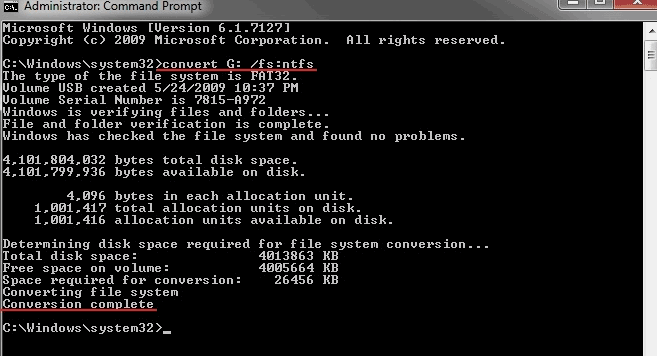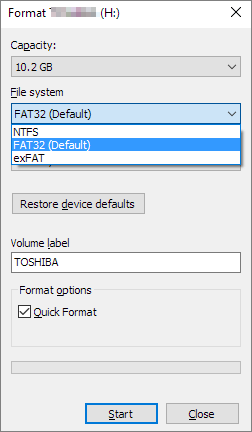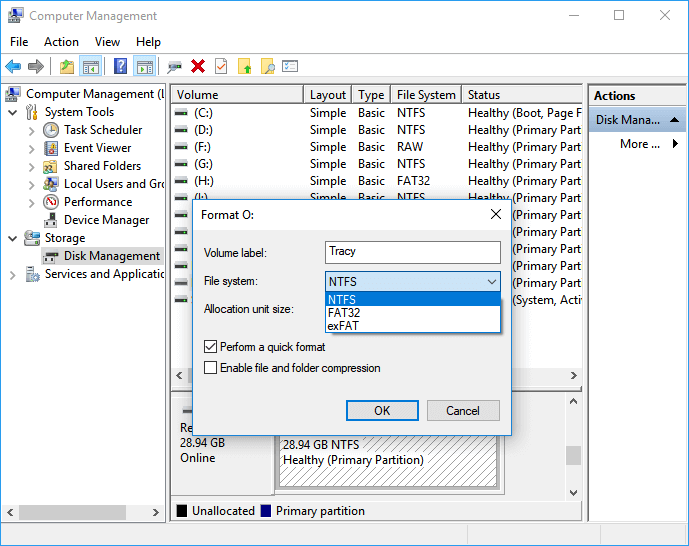Format USB Drive to NTFS in Windows 10 (All 4 Ways)
File systems are ways of organizing data. For better performance, people need to choose certain file systems in different situations. In this case, some users might try to format the USB drive to NTFS in Windows 10for different reasons. For example, change the file system to copy files too large for FAT32, fixing RAW USB drive, restore USB drive back to full capacity, etc. But how to manage this job without losing data is really a bit challenging if you know little about computer and hard drive.
So on this page, we introduce you four simple ways to format or reformat USB drive to NTFS. Some of them allow you to keep your data. So, you can try the one that works best for your case. In addition, these solutions can be also applied to format SD card, external hard drive, pen drive or other removable storage devices to NTFS.
If there are a ton of files on the USB drive and you don't have the free space to move them around, you can directly convert the file system of the flash drive to NTFS without formatting or losing data. Here you can try to do this job in two ways:s:
| Workable Solutions | Step-by-step Troubleshooting |
|---|---|
| Two ways to convert USB to NTFS in Windows 10 without formatting |
Method 1. Convert to NTFS using cmd: press Windows + X keys to bring up the context menu...Full steps Method 2. Convert to NTFS with Qiling partition...Full steps |
| Format USB drive to NTFS in Windows 10 with Windows formatting tool |
Method 1. Format USB drive to NTFS using Windows File Explorer...Full steps Method 2. Format USB drive to NTFS using Disk Management: Right-click on This PC and then...Full steps |
Two ways to convert USB to NTFS in Windows 10 without formatting
Method 1. Convert to NTFS using cmd
1. In Windows 10. press Windows + X keys to bring up the context menu
2. Choose Command Prompt (Admin) to open up an Administrator mode command.
2. Type convert (drive letter): /FS:NTFS, for example, convert G: /FS:NTFS.

After several simple steps, Windows will immediately start the file system conversion job. It might take a while, especially if you've got a really large drive.
Method 2. Convert to NTFS with Qiling free partition software
If the cmd method exceeds your understanding and you cannot stand the risk, you can try the second way - convert USB drive to NTFS with third-party free software. Here we recommend Qiling Partition Master Free. The program is a free and easy-to-use disk & partition management tool for Windows 10/8.1/8/7/XP/Vista. It can help you format or convert USB drive to NTFS in Windows 10/8/7 or other previous versions successfully in just several simple clicks.
Step 1. Install and launch Qiling Partition Master on your computer.
Step 2. Select a FAT32 partition, right-click on it and select "Convert to NTFS". If you need to convert a storage device such as SD card or USB flash drive to NTFS, insert it into your PC first and repeat the previous operation.
Step 3. Click "OK" on the pop-up dialog box to continue.
Step 4. Now the converting process will start automatically. Wait until the operation process is finished.
And if there is no important data on your USB flash drive or other devices, you can directly choose "Format Partition" in step 1 to format USB drive to FAT32 or NTFS in Windows 10/8/7. In the same way, you can try to do this job with Windows free built-in disk formatting tools.
Format USB drive to NTFS in Windows 10 with Windows formatting tool
Since directly formatting a disk will erase data, you must copy important files and place them to a safe location before proceeding with the following two methods. In case you'll need to recover data from formatted USB drive, Deep Data Recovery would make it easy to bring back the loss with success. success.
Method 1. Format USB drive to NTFS using Windows File Explorer
1. Open Windows 10 File Explorer (Windows + E), locate and right-click on the USB drive, select "Format".
2. Set the NTFS as the target file system, tick "Quick Format" and click "Start" to start the formatting.
3. When the process completes, click "OK" to confirm. And now your USB is NTFS.

Method 2. Format USB drive to NTFS using Disk Management
1. Right-click on This PC and then Manage and select "Disk Management".
2. Locate and right-click on your USB flash drive or external hard drive, and then select "Format".
3. Set the USB file system to NTFS, tick "Quick Format" and click "OK" to confirm.

To Sum Up
According to the methods above, you have four ways to format your USB drive or USB stick to NTFS in Windows 10/8/7. It requires little time and effort. You can choose according to your own preferences. Since formatting USB to NTFS via File Explorer and Disk Management brings data loss, you should take data recovery and creating a backup into account.
Apart from looking for the best way to format USB drive in Windows 10, people also ask questions in the following:
1. Why am I unable to format USB drive Windows 10?
In case your USB drive is corrupted in a way, it will fail to format once you right-click on it and format in Widows Explorer. At this moment, you need to format the USB drive using cmd or disk formatting tool.
2. How to format a flash drive on Mac?
To format the USB drive to FAT32, follow the next steps:
- Connect the USB flash drive to your Mac computer.
- Go to Applications > Utilities > Double click and open Disk Utility.
- Select your USB flash drive on the sidebar, choose Erase.
- Rename the USB flash drive, choose the format as MS-DOS (FAT) for Format, Master Boot Record for Scheme. Then click Erase.
- Read more>>
3. Should I format USB drive to FAT32 or NTFS?
FAT32 is compatible with all operating systems since it's a simple file system and has been around for a really long time. In contrast, NTFS is more robust and effective than FAT as it adopts advanced data structures to improve reliability, disk space utilization and overall performance. The application of NTFS has grown but FAT32 is still more universal.
If you're looking to decide which file system to use when formatting a USB drive, most of all, you should consider two of the most important aspects: portability and file size limits when made your own decision. Read more>>
Related Articles
- [Fixed] Windows Cannot be Installed to This Disk. The Selected Disk is of the GPT Partition Style
- Fix 'The Specified Disk Is Not Convertible' Error in Windows
- Can I Install Windows 11 on Windows 10? Download Windows 11 Now
- Don't Miss Best FAT32 Formatter: How to Choose A Free FAT32 Format Tool